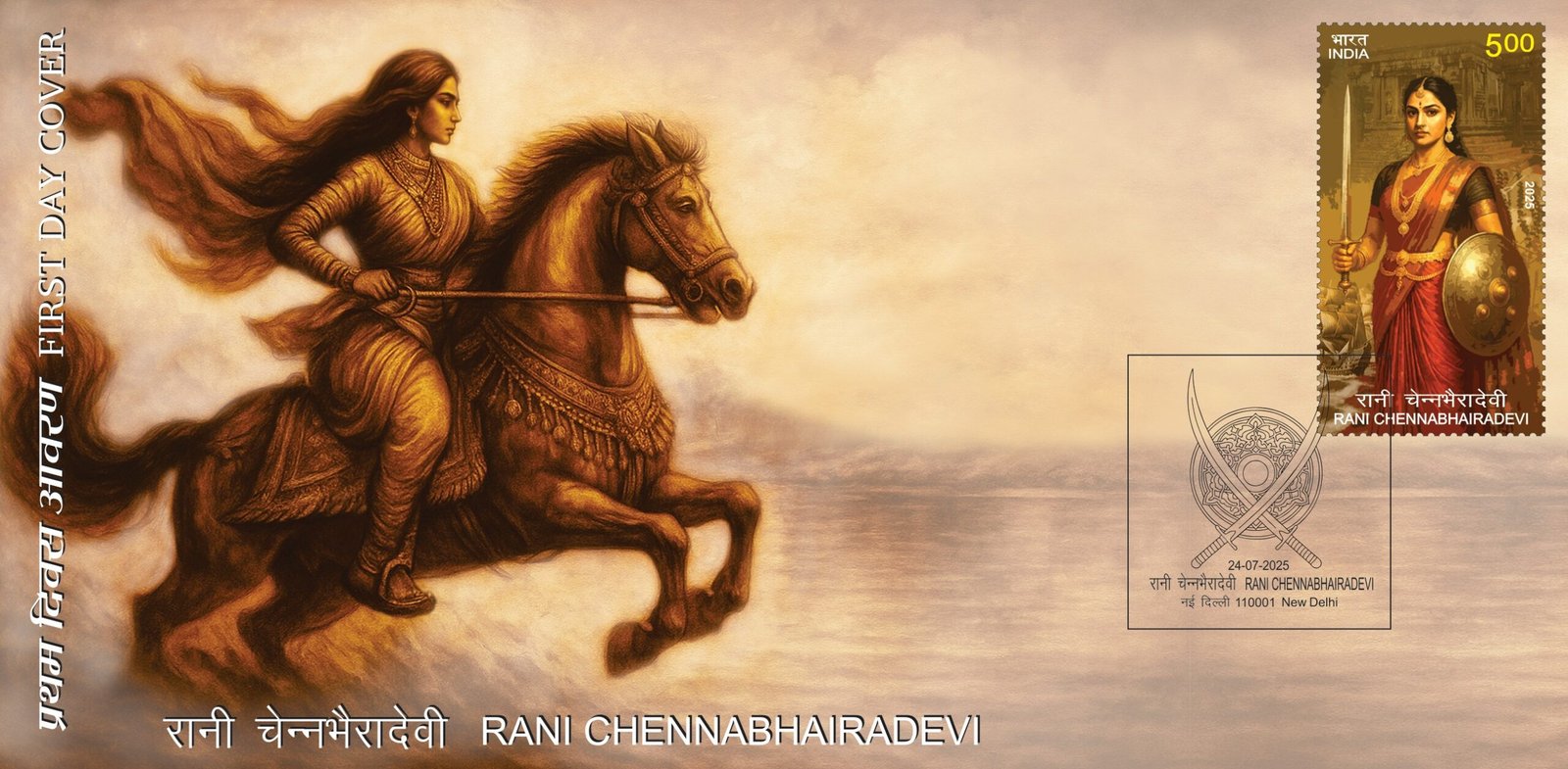Rani Chennabhairadevi

Technical Data
| Date of Issue | July 24, 2025 |
|---|---|
| Denomination | Rs. 5 |
| Quantity | 303,650 |
| Printer | Security Printing Press, Hyderabad |
| Printing Process | Wet Offset |
| Colors | Multicolor |
| Credit (Designed By) | Mr. Anuj Kumar |
| Catalog Codes |
Colnect codes IN 2025.07.25-01 |
| Themes | Famous people | Queens | Weapons | Women |
Rani Chennabhairadevi – The Pepper Queen of Gerusoppa
In the history of the Indian subcontinent, Queen Chennabhairadevi stands out as a ruler of extraordinary courage, wisdom, and resilience. Revered as Raina-Da Pimenta (the Queen of Pepper), she was one of the longest-reigning women monarchs, ruling for over five decades—between 1552 and 1606—at a time when kingdoms faced constant external threats and internal challenges.
Rise of a Young Queen
Born into the illustrious lineage of coastal Karnataka, Chennabhairadevi received her early education at the Ghatikasthana of Haduvalli. She was not only well-versed in administration and scholarship but also trained rigorously in warfare and naval combat, acquiring the skills needed to defend her land. At just eighteen, she assumed leadership as Mahamandaleshwari of Haduvalli under the Vijayanagara Empire. Soon after, she was entrusted with ruling Gerusoppa, following in the footsteps of her maternal uncle.
Defender of the Realm
Surrounded by hostile neighbors—the rulers of Keladi, Bilagi, and the Portuguese in Goa—Queen Chennabhairadevi never bowed to intimidation. She maintained friendly ties with powers like the Honneya Kambali rulers, the Bhairarasas of Karkala, and the Zamorins of Kerala, and even secured a treaty with the Sultan of Bijapur while remaining loyal to the Vijayanagara emperors.
Twice—in 1558 and 1569–70—she successfully repelled Portuguese invasions at Honnavar, and also defeated the Keladi rulers in battle. Despite constant threats, her reign ensured prosperity, safety, and inclusiveness, where people of different faiths, communities, and professions lived together in harmony.
The Pepper Queen
Chennabhairadevi was as visionary in commerce as she was valiant in battle. At a time when black pepper was merely a forest product, she promoted its cultivation among Malnad and coastal farmers, transforming it into a major trade commodity. Under her guidance, exports of pepper, rice, cardamom, cinnamon, jaggery, betel nut, sandalwood, ginger, cloves, and ivory flourished.
Though politically opposed to the Portuguese, she shrewdly maintained commercial relations with them, ensuring that her kingdom remained wealthy through international trade. It was for this reason that scholars like Dr. Hannah Chapelle Wojciechowski noted the Portuguese themselves conferred on her the title Raina-Da Pimenta, the Queen of Pepper.
Protector of the Oppressed
The 1560s saw the Portuguese intensify forced conversions in Goa through the Inquisition Court, devastating communities like the Saraswats, Kharvis, and fishermen. These groups, rendered homeless and destitute, found refuge under Queen Chennabhairadevi. She not only offered them protection but also integrated their skills into her economy, providing them with livelihood and dignity.
Diplomatic and Strategic Wisdom
After the fall of the Vijayanagara Empire in 1564, when efforts were made to revive it from Penukonda, she extended resources to support its resurgence. Such was her strength that Portuguese records reveal a letter from their king to the governor of Goa, instructing him to handle her with “humility, prudence, and diplomatic wisdom.”
A Lasting Legacy
Through her remarkable rule, Queen Chennabhairadevi built a kingdom that was prosperous, secure, and globally connected. Her reign, spanning over half a century, is a testimony to her resilience and foresight. More than 500 years ago, she stood as a symbol of women’s leadership, proving that compassion, diplomacy, and courage could guide a nation even in turbulent times.
A Philatelic Tribute
The Department of Posts proudly releases a commemorative postage stamp in honour of Queen Chennabhairadevi, the fearless monarch of Gerusoppa. This stamp is a tribute to her unmatched legacy as a warrior, strategist, and reformer, and a reminder of the powerful role women have played in shaping India’s history.
First Day Cover

